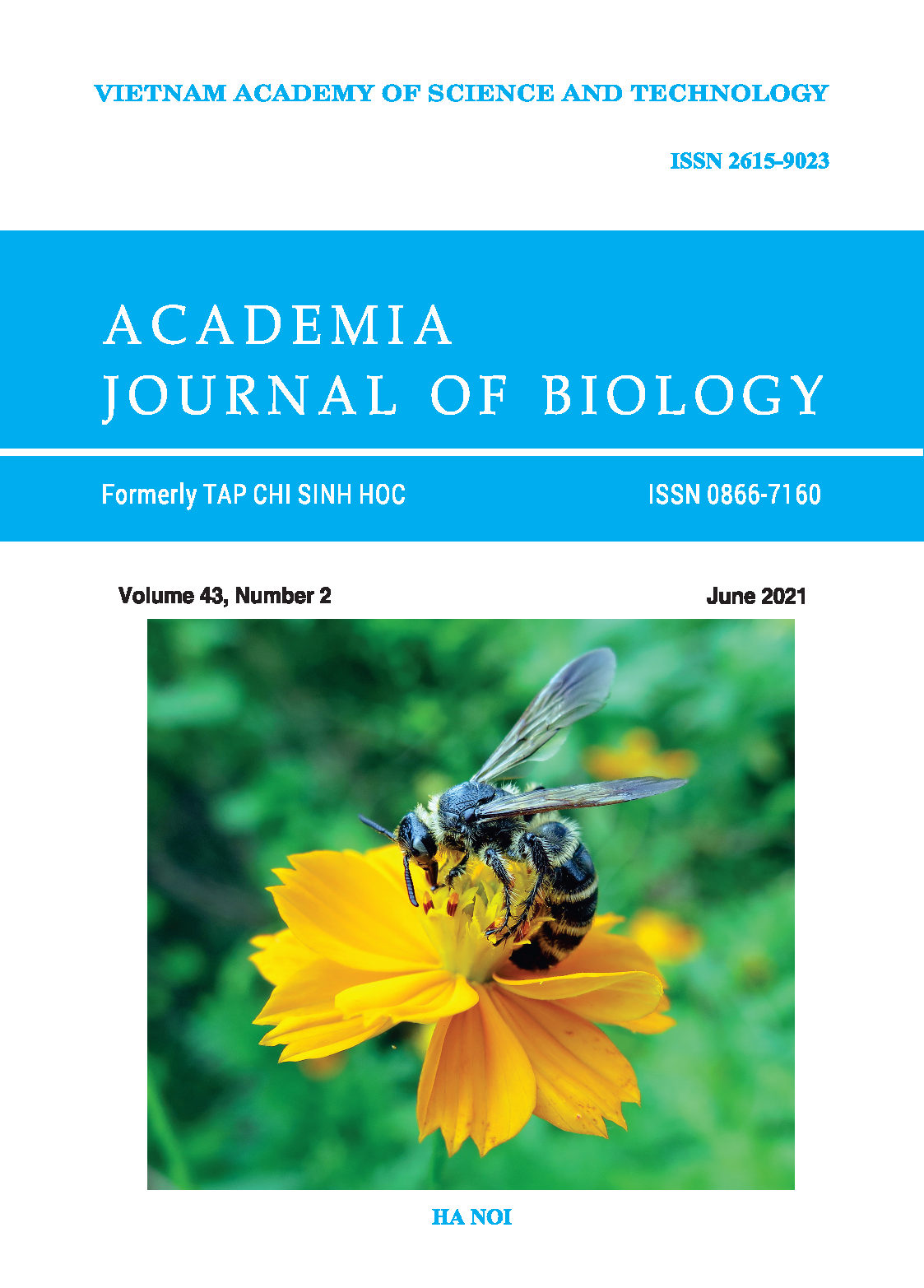Optimization of cultivation conditions of the heterotrophic marine microalga
Author affiliations
DOI:
https://doi.org/10.15625/2615-9023/15814Keywords:
Thraustochytrium aureum, cultivation conditions, DHA, PUFAsAbstract
Thraustochytrium is a heterotrophic marine microalgae genus belonging to the Labyrinthula class, Thraustochytriaceae (Thraustochytrids) family. Recently, studied results have showed that some species/strains of Thraustochytrium genus are potential candidates to produce biomass rich in lipid containing high polyunsaturated fatty acid (PUFAs), especially docosahexaenoic (DHA C22: 6 ω-3), carotenoid, extracellular polysaccharides (EPSs) and enzymes which play a crucial role in human health. Therefore, throughout many decades, numerous studies have been conducted in exploiting bioactive compounds, especially PUFAs. Biomass and PUFAs yield of some strains Thraustochytrium spp. depend on environmental conditions. In this paper, the results on the effects of different culture conditions on the growth of Thraustochytrium aureum BT6 (isolated from coastal regions of Binh Thuan in 2010) in 500 mL erlenmeyer flask and 30 L fermentors is presented. Suitable conditions for the growth of strain BT6 were: Bajpai medium, 2% glucose, 0.5% yeast extract, temperature of 20−28 oC, salt concentration 0.5%; and initial algal cell concentration of 2 g/L. The dry biomass, lipid and DHA contents of strain BT6 in 500 mL erlenmeyer flasks and 30 L fermentor reached the highest levels of 8.56 ± 0.12 and 6.92 ± 0.27 g/L, 18.36 ± 1.15 and 5.50 ± 0.133% DCW, 2.00 ± 0.05 and 0.14 ± 0.01% DCW, respectively, after 4 days of cultivation. Carotenoid content in flask and 30L fermentor achieved 44.45 ± 1.4 and 28.84 ± 1.12 mg/kg DCW, respectively after 4 days of cultivation. Obtained results have indicated that the algae biomass met the requirements in orientation to exploit valuable bioactive compounds.
Downloads
Metrics
References
Aki T., Hachida K., Yoshinaga M., Katai y., Yamasaki T., Kawamoto S., Kakizono T., Maoka T., Shigeta S., Suzuki O., Ono K., 2003. Thraustochytrid as a potential source of carotenoids. J. Am. Oil. Chem. Soc., 80(8): 789−794.
Anbu P., Kim D. U., Jeh E. J., Jeong Y. S., Hur B. K., 2007. Investigation of the physiological properties and synthesis of PUFAs from thraustochytrids and its electrophoretic karyotypes. Biotechnol. Bioprocess. Eng., 12(6): 720−729.
Bajpai P. K., Bajpai P., Ward O. P., 1991. Optimization of production of docosahexaenoic acid (DHA) by Thraustochytrium aureum ATCC 34304. J. Am. Oil. Chem. Soc., 68: 509−514.
Bligh E. G., Dyer W. J., 1959. A rapid method of total lipid extraction and purification. Can. J. Biochem. Phys., 37(8): 911−917.
Burja A. M., Armenta R. E., Radianingtyas H., Barrow C. J., 2007. Evaluation of fatty acid extraction methods for Thraustochytrium sp. ONC-T18. J. Agric. Food. Chem., 55: 4795−4801.
Caamaño E., Loperena L., Hinzpeter I., Pradel P., Gordillo F., Corsini G., Tello M., Lavín P., González A. R., 2017. Isolation and molecular characterization of Thraustochytrium strain isolated from Antarctic Peninsula and its biotechnological potential in the production of fatty acids. Braz. J. Microbiol., 48(4): 671−679.
Dang D.H., Hoang T.L.A., Ngo T.H.T., 2011. Study on biological characteristics of heterotrophic marine microalga - Schizochytrium mangrovei PQ6 isolated from Phu Quoc Island, Kien Giang province, Vietnam. J. Phycol., 47(4): 944−954.
Dang Diem Hong, 2019. The cultivation of microalgae rich in nutrition used for functional food and animal feed in Vietnam. Monographs. Natural resources and environment of Vietnam. Publisher of Science and Technology, pp. 750 (in Vietnamese).
Dang Diem Hong, Hoang Thi Lan Anh, 2016. New Heterotrophic marine microalgae of
Labyrinthula, Schizochytrium, Traustochytrium in Vietnam: Potential and Challenges. Monographs. Natural resources and environment of Vietnam. Publisher of Science and Technology, pp. 625 (in Vietnamese).
Furlan V. J. M., Batista I., Bandarra N., Mendes R., Cardoso C., 2019. Conditions for the Production of Carotenoids by Thraustochytrium sp. ATCC 26185 and Aurantiochytrium sp. ATCC PRA-276. Journal of Aquatic Food Product Technology., 28(5): 465−477.
Furlan V. J. M., Paulo M. D. C., Maus V. W., Ferreira J., Batista I., Bandarra N. M., 2017. Production of docosahexaenoic acid (DHA) from Thraustochytrium sp. ATCC 26185 using differents nitrogen concentrations. Bol. Cent. Pesqui. Process. Aliment., 34(2):1−11
Hang N. T. M., Giap T. H., Thanh N. L., Oanh N. T. T., Hong D. D., Minh C. V., 2019. Metabolies from microalgae Schizochytrium mangrovei. Joural of Natural Compound., 55: 978−981.
Hoang Thi Lan Anh, Dinh Thi Ngoc Mai, Ngo Thi Hoai Thu, Dang Diem Hong, 2010. Isolation of a new heterotrophic marine microalgae strain of the genus Thraustochytrium rich in DHA and carotenoid from the Thi Nai - Binh Dinh mangrove forest. Journal of Biotechnology 8 (3A): 459−465 (in Vietnamese with English summary).
Imamoglu E., Sukan F.V., Dalay M.C., 2007. Effect on different culture media and light intensities on growth of Haematococcus pluvialis. Int. J. Nat. Eng. Sci., 1: 05−09.
Jeh E. J., Kumaran R. S., Hur. B. K., 2008. Lipid body formation by Thraustochytrium aureum (ATCC 34304) in response to cell age. Korean. J. Chem. Eng., 25: 1103–1109.
Miller G.L., 1959. Use of dinitrosalicylic acid reagent for determination of reducing sugar. Anal. Chem., 31 (3): 426−428.
Nguyen Lam Minh, Tran Thi Xuan Mai, Nguyen Thi Lien, 2018. Design of specific primers for the identification of Thraustochytrids. Huaf Journal of Agricultural Science and Technology, 2(1): 509−518 (in Vietnamese with English summary).
Shene C., Leyton A., Rubilar M., Pinelo M., Acevedo F., Morales E., 2013. Production of lipids and docosahexasaenoic acid (DHA) by a native Thraustochytrium strain. Eur. J. Lipid. Sci. Technol., 115: 890−900.
Singh P., Liu Y., Li L. S., Wang G. Y., 2014. Ecological dynamics and biotechnological implications of Thraustochytrids from marine habitats. Appl. Microbiol. Biotechnol., 98: 5789−5805.
Tran Thi Xuan Mai, Nguyen Phi Nga, Nguyen Thi Lien, Nguyen Van Be, 2015. Isolation and identification of thraustochytrid heterotrophic microalga for production of carotenoids. Science Journal of Can Tho University, 37(1): 57−64 (in Vietnamese with English summary).
Xiao R., Li X., Zheng Y., 2018. Comprehensive study of cultivation conditions and methods on lipid accumulation of a marine protist Thraustochytrium striatum. Protist., 169(4): 451−465. https://doi.org/10.1016/ j.protis.2018.05.005





